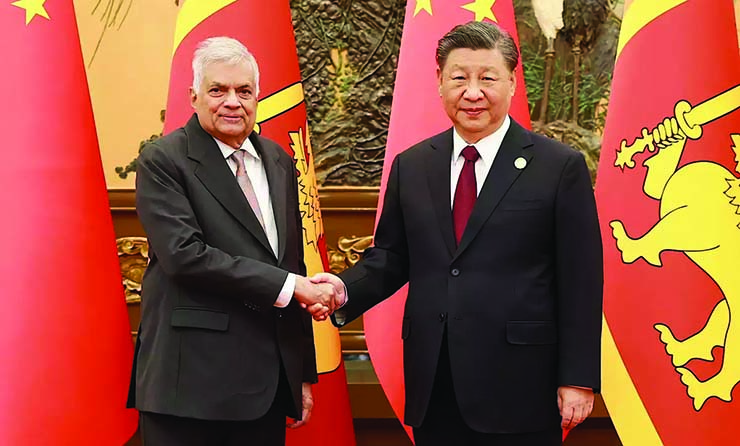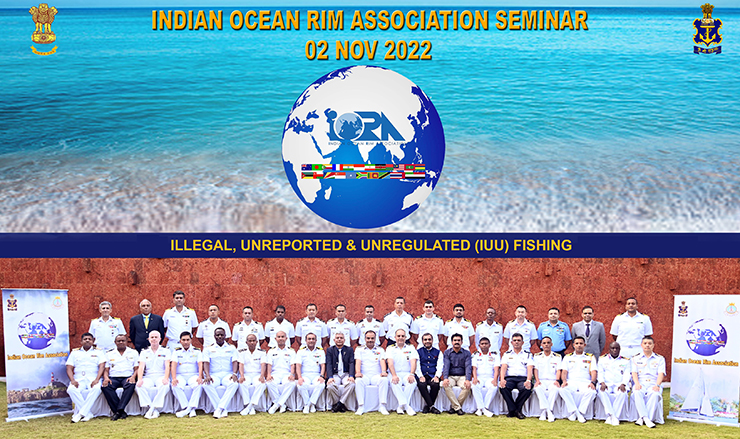
On October 15, 2023, the ferry service between India and Sri Lanka was resumed after a gap of 40 years. From the early 1900s to 1982, the Indo-Ceylon Express ran between Chennai and Colombo via Thoothukudi Port till it was disrupted by the civil war in Sri Lanka. The new high-speed ferry ‘Cheriyapani’ now runs from Nagapattinam in Tamil Nadu to Kankesanthurai in Jaffna and back, a one-way journey taking four hours. The initiative is aimed at bolstering bilateral ties, boosting tourism, trade and people-to-people relations.
Subsequent media reports said the Sri Lankan Navy arrested 21 Indian fishermen of Rameshwaram on charges of poaching and impounded their boats. This number added to the 64 Indian fishermen from Ramanathapuram district arrested and their boats impounded within a fortnight. All these arrests were made between October 13 and October 27. According to the fishermen leader NJ Bose, the fishermen were operating in Indian waters, and fishing in Palk Bay has become high risk and insecure since Sri Lankan Naval authorities arrested them under one pretext or another.
Next was the news that Sri Lanka had permitted China’s so-called research ship ‘Shi Yan 6’ to dock at Colombo Port on October 25 despite India’s maritime security concerns. The docking was supposedly for “replenishment and survey in Sri Lanka’s Exclusive Economic Zone (EEZ)”. According to Kapila Fonseka, Sri Lanka’s foreign ministry spokesman, the Chinese vessel was allowed to dock at Colombo up to October 28. However, this does not address India’s genuine security concerns in any manner.
In August 2023, the Chinese warship ‘Hai Yang 24’, which has considerable surveillance capabilities, docked at Colombo Port. Earlier in April 2022, China’s other so-called research-cum-spy ship ‘Yuan Wang 5’, which specialises in spacecraft tracking, sailed into Sri Lanka’s Hambantota Port and was welcomed by Sri Lankan and Chinese officials. Sri Lanka referred to the Yuan Wang 5 as a “scientific research ship”, which is an apparent Chinese cover.
The real purpose of China’s survey-research-spy vessels, like the ‘Yuan Wang 5’ and ‘Shi Yan 6’, is to collect seabed, hydrological, subsea cable data and record telemetry data of India’s missile firings. All this will help PLA Navy’s (PLAN’s) military missions in the Indian Ocean Region (IOR), including Chinese submarines navigating in shallow waters of Malacca Straits and the eastern IOR through the US Navy’s ‘fish-hook’ sensor networks to detect entry of Chinese submarines. In addition, the tracking systems of these spy vessels and Chinese warships like the Hai Yang 24 would be tasked to snoop on Indian defence installations while sailing towards the Sri Lankan ports.
Colombo Port City and the Hambantota Port are signature projects of the BRI. In addition, Sri Lanka has welcomed further investments from Chinese enterprises in the Colombo Port City and expressed readiness to create a conducive environment for investments that would include requisite legislative measures
A significant development is Sri Lanka reiterating its commitment to China’s Belt and Road Initiative (BRI) during the recent visit of Sri Lankan President Ranil Wickremesinghe to Beijing from October 16 to 20. The China-Sri Lanka joint statement reads: “Sri Lanka reiterates that it will continue to actively participate in the Belt and Road Initiative proposed by China. The two sides agreed to sign the Memorandum of Understanding on jointly accelerating the formulation of the cooperation plan on the Belt and Road Initiative.”
Amid signing several agreements and MoUs, the two sides recognised that Colombo Port City and the Hambantota Port are signature projects of the BRI. Sri Lanka welcomed further investments from Chinese enterprises in the Colombo Port City and expressed readiness to create a conducive environment for investments in the Port City that would include requisite legislative measures.
At the conclusion of the Indian Ocean Rim Association (IORA) Council of Ministers meeting in Colombo on October 11, Indian External Affairs Minister S Jaishankar said in a press meet, “We should be clear where the dangers are, be it in hidden agendas, in unviable projects or in unsustainable debt. Exchange of experiences, sharing of best practices, greater awareness and deeper collaboration are part of the solution.” This was a clear warning concerning China’s debt trap policy, not that Sri Lanka and the other IORA countries are not aware of this.
“We should be clear where the dangers are, be it in hidden agendas, in unviable projects, or unsustainable debt. Exchange of experiences, sharing of best practices, greater awareness and deeper collaboration are part of the solution,” says S Jaishankar
Sri Lanka’s active participation in China’s BRI no doubt has adverse ramifications for the Indo-Pacific, especially for India, given the state of India-China relations. At the same time, we need to acknowledge the following:
- Sri Lanka suffered an unprecedented economic crisis last year, defaulting on a US$ 46 billion external debt, partly because of Chinese loans and infrastructure projects.
- China is Sri Lanka’s single-largest bilateral creditor with a loan of US$ 7 billion.
- China is the largest investor in Sri Lanka with funding and investment of nearly US$ 15 billion.
- In July 2017, Sri Lanka’s Hambantota Port was officially transferred to China for 99 years because of debt repayment default.
- Chinese nuclear submarines and warships do not dock at berths of Sri Lanka Port Authority (SLPA) in Colombo mandated to accommodate military vessels but instead at the Colombo South Container Terminal (CSCT), a deep-water facility built, controlled and run by China through an aid project – a Chinese enclave within a Sri Lankan administered harbour.
- Sri Lanka wants to reschedule its debt repayment with China but Beijing has been avoiding the same by saying it would support negotiations between Sri Lanka and China’s Exim Bank. During his visit to Beijing, Wickremesinghe also met Chinese President Xi Jinping, who assured China would provide “friendly, practical and timely support for Sri Lanka’s debt optimization program.”

- The International Monetary Fund (IMF) signaled recently Sri Lanka would get US$ 330 million once the IMF Management and Executive Board approves the same. No time schedule has been indicated. The IMF bailout is expected to facilitate additional support of US$ 3.75 billion plus from the World Bank, Asian Development Bank and other lenders; enabling Sri Lanka to rework part of its $84 billion public debt.
- On September 20, 2023, the US committed an additional US$ 19.2 million in USAID to Sri Lanka.
- India, the UAE, Saudi Arabia, the EU, France, Germany and the US are involved in the India-Middle East-Europe Economic Corridor (IMEC), which is seen as competition to China’s BRI, of which Sri Lanka is an important part. At the same time, the IMEC could get disrupted if the Israel-Hamas war engulfs the Middle East.
- Sri Lanka’s Rajapaksa clan, considered the top nepotistic political dynasty of South Asia, has a presence in the government, opposition and government posts and with Chinese leanings, continues to influence decision-making in Sri Lanka.
China will go all out to woo Sri Lanka including easing Sri Lanka’s woes and extending full support to the Ranil Wickremesinghe government in Sri Lanka’s parliamentary elections scheduled in 2024, followed by provincial council elections in 2025
China’s new foreign policy calls for prioritising relations with neighbours but makes little mention of India. The policy also warns of the Cold War resurfacing. Sri Lanka will have a central role in China’s multidimensional BRI. China will go all out to woo Sri Lanka including easing Sri Lanka’s woes and extending full support to the Ranil Wickremesinghe government in Sri Lanka’s parliamentary elections scheduled in 2024, followed by provincial council elections in 2025.
Of serious concern is China’s growing influence all around India; Pakistan, Nepal, Myanmar, Sri Lanka, Maldives and even direct parleys with Bhutan. But if this was not enough, the US is sparing no effort to bring back the Khaleda Zia government in Bangladesh with full knowledge that Bangladesh under her rule earlier was blatantly pro-China and Pakistan.
The US finds its Ukraine project floundering, Taiwan and Israel are 1/16th and 1/28th the size of Ukraine respectively but India is large and America sees a much better chance to advance its national interests, benefiting strategically and economically in the event of an India-China war.
In sharp contrast to China, India’s policy of ‘Neighbours First’ is reduced more to rhetoric than substance; a dismal enterprise if one looks around. This is because the national hierarchy is focused on projecting itself on the global stage and offering to mediate conflicts around the world, ignoring the noose tightening around us.
-The author is an Indian Army veteran. Views expressed are personal.








